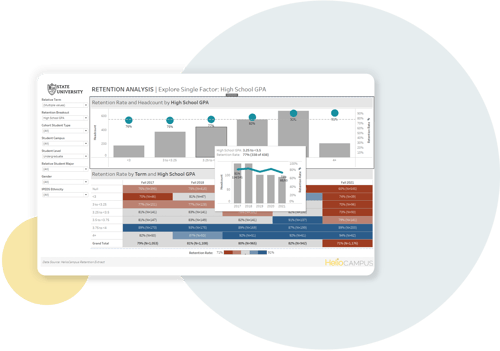Essential insights to drive student success and grow revenue
Student success – and the revenue associated with matriculating and graduating those students – hinges on many of the invisible dots occurring between recruitment events, classroom engagement, and long-term financial goal achievement. Bringing visibility to these connections increases your institution’s power to impact desired results.
Optimized student lifecycles, healthier revenues
Next-level recruitment analytics
By surfacing previously unseen connections between recruitment data and student success, your enrollment management team can now focus, not only on following statistical progressions in tracking their ability to hit enrollment targets, but they can also unearth academic, social, financial, and other data points which lead to successful graduates. Delivering a class which not only meets statistical needs but also possesses heightened probability of retention, graduation, and alumni reciprocity—that’s next-level decision-making power.
Yield-maximizing financial aid packaging
Balancing the institution’s discount rate while checking the appropriate boxes for grants and scholarships is FinAid 1.0. Delve deeper into the data to explore where the tipping point for unmet financial need leading to stall-out, stop-out, and drop-out exists. Identify what combination of institutional grants and scholarship amounts delivers maximized yield. Recognize what aid types are most likely to promote student success. Graduate from dollars in a spreadsheet to immediate student impact with greater data clarity.
Deep dive academic programming insights
Tracking how many students are in a major doesn’t unveil the true impact of an academic department. Connect the dots between academic programs, student progress, and success rates to bring increased visibility to programmatic results—and even overall institutional ROI.
Unparalleled student success metrics
Move beyond 4- and 6-year graduation rates to truly identify metrics of ongoing student success. How are students of various ethnicities, genders, geographies, socioeconomic statuses, and other variables faring? What steps and interventions are working with some populations which can be provided to others? Manipulate data to compare subsets of students—whether demographically or academically—to discover trends that yield increased engagement, better course results, and improved graduation rates.
Questions to ask to connect student success with revenue growth
-
What is the probability of hitting our desired enrollment target?
-
What are our enrollment trends by target student populations?
-
How do enrollments compare by class instruction mode?
-
How do I modify my financial aid leveraging strategy to maximize yield?
-
How does financial unmet need impact student retention?
-
How does the trend of graduating student debt differ across the student body?
-
What is the graduation rate of students who graduate in 4 years?
-
How can you break down students into subpopulations to better serve them?
-
Are we recruiting students most likely to be successful at our institution?
-
What kind of student movement occurs across programs, departments, and colleges?
-
What are our historical trends and key metrics in yield, retention, and degree production by academic program?
-
What are the attributes of our most successful students?

Increase student success and grow revenue with HelioCampus
Student Lifecycle
Enable institutional stakeholders to quantify and understand the connections between admissions, enrollment, student success, and financial aid.
-
Measure and improve student persistence and retention
-
Identify areas to optimize recruiting, financial aid, or admissions processes to maximize enrollment yield
-
Empower strategic decision making across academic and administrative functions

Student Lifecycle
Enable institutional stakeholders to quantify and understand the connections between admissions, enrollment, student success, and financial aid.
-
Measure and improve student persistence and retention
-
Identify areas to optimize recruiting, financial aid, or admissions processes to maximize enrollment yield
-
Empower strategic decision making across academic and administrative functions



.png)